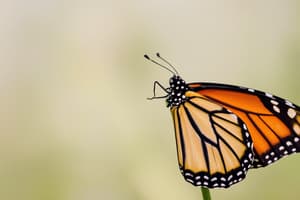Podcast
Questions and Answers
Monarch butterflies can travel up to 3,000 miles during their migration.
Monarch butterflies can travel up to 3,000 miles during their migration.
True (A)
The lifespan of migrating monarchs is generally longer than that of their parents and grandparents.
The lifespan of migrating monarchs is generally longer than that of their parents and grandparents.
True (A)
Every single butterfly completes the entire migration journey.
Every single butterfly completes the entire migration journey.
False (B)
Monarch butterflies primarily navigate using their sense of smell.
Monarch butterflies primarily navigate using their sense of smell.
Monarch butterflies cluster in groups during their wintering period in Mexico.
Monarch butterflies cluster in groups during their wintering period in Mexico.
Habitat loss is one of the primary threats faced by monarch butterflies.
Habitat loss is one of the primary threats faced by monarch butterflies.
The primary food source for monarch larvae is the milkweed plant.
The primary food source for monarch larvae is the milkweed plant.
Temperature changes do not affect monarch butterfly migration patterns.
Temperature changes do not affect monarch butterfly migration patterns.
The journey of monarch butterflies includes laying eggs along the way as they travel north.
The journey of monarch butterflies includes laying eggs along the way as they travel north.
The migration of monarch butterflies happens in the spring only.
The migration of monarch butterflies happens in the spring only.
Flashcards
Monarch Migration
Monarch Migration
The incredible journey undertaken by monarch butterflies every year, spanning up to 3,000 miles from their breeding grounds in North America to their wintering grounds in Mexico.
Super Generation
Super Generation
A group of monarch butterflies that take part in the annual migration and have a longer lifespan than other generations.
Monarch Navigation
Monarch Navigation
The process by which monarchs use environmental cues like the sun and Earth's magnetic field to find their way south.
Gliding
Gliding
Signup and view all the flashcards
Monarch Overwintering Sites
Monarch Overwintering Sites
Signup and view all the flashcards
Milkweed
Milkweed
Signup and view all the flashcards
Habitat Loss
Habitat Loss
Signup and view all the flashcards
Climate Change
Climate Change
Signup and view all the flashcards
Pesticide Use
Pesticide Use
Signup and view all the flashcards
Monarch Conservation
Monarch Conservation
Signup and view all the flashcards
Study Notes
Monarch Butterfly Migration
- Monarch butterflies undertake an incredible journey of up to 3,000 miles annually between North America and Mexico.
- Migration begins in late summer/early fall, guided by environmental cues like sun position and magnetic fields.
- The migrating butterflies, called the "super generation," have a longer lifespan (up to eight months) compared to previous generations.
- Monarchs conserve energy by gliding on air currents to travel long distances.
- In Mexico, monarchs cluster in fir trees by the thousands, creating stunning displays of color.
- These clusters in Mexican mountains offer a perfect winter climate for the butterflies' rest.
- Monarchs begin their northward journey in spring, laying eggs along the way.
- Their offspring continue the migratory cycle.
Threats to Monarch Butterflies
- Habitat loss significantly impacts monarch populations.
- Climate change poses a threat to monarch butterfly survival.
- Pesticide use negatively impacts monarch numbers.
- Conservation efforts focus on planting milkweed, their primary food source.
Studying That Suits You
Use AI to generate personalized quizzes and flashcards to suit your learning preferences.
Description
Test your knowledge on the remarkable migration of monarch butterflies. Learn about their incredible journey from North America to Mexico and the challenges they face along the way. Discover the unique traits of the 'super generation' and why their migration is vital for survival.




